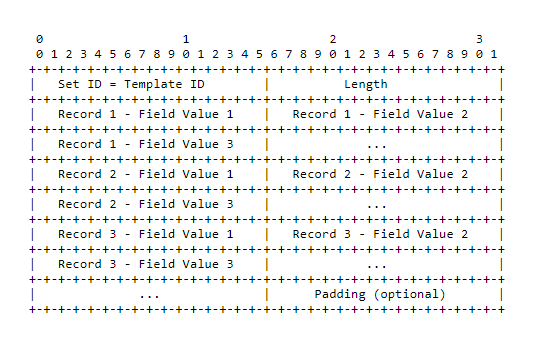Performance Monitoring Collection
Introduction
The BAA layer provides the capability to collect performance monitoring (PM) data from managed pANs and then store the collected PM data as the corresponding standardized data model's PM YANG data elements.
The primary responsibility of the PM Collection Framework is to:
-
Collect PM data from managed devices
-
Translate the PM data into the associated data elements defined by standardized pAN's YANG modules defined in the BBF's TR-413 specification.
Once the data is translated into the data elements of the standardized pAN's YANG modules, the PM Collection Framework hands the translated data off to a data handler for storage.
Once stored the PM data is accessible to SDN Management and Control (SDN M&C) elements for their specific functions (e.g., analysis, troubleshooting). Access to the data store is through the Northbound Interface of the BAA layer through direct access to the PM datastore.
PM Collection Framework
The PM Collection Framework is a generalized framework that permits collection of PM data using various protocols and mechanisms (e.g., IPFIX, SFTP).
The determination of which PM Collector is used by the pAN is accomplished by configuring the pAN with the associated PM collection template that includes information on what PM data the pAN is to collect; the interval schedule to collect and report the collected PM data and finally how the collected PM is transported to the associated PM Collector in the BAA layer.
The figure below provides a high level overview of the PM Collection Framework:

In this release, the PM data collection framework supports the IPFIX protocol and mechanisms as IPFIX is the method defined by the BBF's TR-383 specification.
IPFIX Collector
The IPFIX PM Data Collector (IPFIX Collector) is based standardized within the BBF's TR-383 Common YANG specification for Access Nodes and is based on the IETF's RFC 7011 IPFIX protocol specification.

Within RFC 7011, IPFIX supports multiple transport protocols (e.g., TCP, UDP, SCTP), for the BAA layer implementation, the IPFIX collector is based on the TCP transport protocol described in section 10.4 of RFC 7011.
The IPFIX template for PM data collection uses the YANG configuration data model for IPFIX and Packet Sampling (PSAMP) protocols as defined in section 6 of RFC 6728 for the IPFIX PM data collection template.
Note: While the BAA layer uses the IPFIX template to configure the pAN with the information elements, the BAA layer needs additional information to manage the PM collection with a pAN. These elements include items such as enabling/disabling the collection of PM data, maintenance/persistence method (on-demand, always open) of the IPFIX session and any session authentication information. This information is defined in the bbf-obbaa-network-manager.yang.
IPFIX Collector Translation Function
The IPFIX Collector's translation function accepts PM data encoded as IPFIX information elements in IPFIX messages and decodes these elements into corresponding standard pAN YANG leaf nodes and instances.
Decoding of IPFIX Messages
The IPFIX Collector receives IPFIX messages and based on the IPFIX Set ID, decodes the information within the message.
| Set ID | Set Type |
|---|---|
| 0-1 | Unused |
| 2 | Template Sets |
| 3 | Options Template Sets |
| 4-255 | reserved for future use |
| 256 and above | Data sets |
The decoding procedure is specific to the Set Type.
Decoding Template and Options Template Sets
We will support IPFIX decoding only when the Enterprise bit is enabled. In that case vendor specific mappings will be considered for the IE ID mapping and OBBAA will not be bundled with any default IEid mapping file. The name of this mapping file should be IPFIX_IEId.csv and should be included with the southbound adapter used by the pAN. Whenever an adapter is deployed, the adapter should be unzipped to find the IPFIX_IEid.csv mapping file and be placed in a folder that is named <vendor>-<model>-<type>-<interfaceVersion> within the common mount point. This mount point is configurable from the docker compose file using ipfix : IPFIX_IE_MAPPING_DIR. The following is a Sample IEid mapping.csv. The columns of this csv mapping file is similar to that specified in the IANA specific mapping file. Details of each column in the IPFIX_IEid.csv is as follows:
| Column name | Column description |
|---|---|
| ElementID | A numeric identifier of the Information Element (counter or metric) from the IPFIX stream. |
| Name | A unique and meaningful name for the mapping of the Information Element. This name should be reference to the YANG leaf node preferably in xpath format. |
| Abstract Data Type | Data type of the Information Element. One of the types listed in https://tools.ietf.org/html/rfc7012#section-3.1. |
| Data Type Semantics | The integral types are qualified by additional semantic details. Valid values for the data type semantics are specified in https://tools.ietf.org/html/rfc7012#section-3.2. |
| Status | The status of the specification of this Information Element. Allowed values are 'current' and 'deprecated'. All newly defined Information Elements have 'current' status. |
| Description | Description of the Information Element. |
| Units | If the Information Element is a measure of some kind, the units of the measure |
| Range | Some Information Elements may only be able to take on a restricted set of values that can be expressed as a range (e.g., 0 through 511, inclusive). If this is the case, the valid inclusive range SHOULD be specified; values for this Information Element outside the range are invalid and MUST NOT be exported. |
| References | Identifies additional specifications that more precisely define this item or provide additional context for its use. |
| Revision | The revision number of an Information Element, starting at 0 for Information Elements at time of definition and incremented by one for each revision. |
| Date | The date of the entry of this revision of the Information Element into the registry. |
ElementID, Name and Abstract Data Type are mandatory fields that needs to be filled for any particular Information element.
Note: We will not support decoding of Template/Option Template Sets if the Enterprise bit is disabled, because there is no standard IEid mapping file defined. Standard IEid mapping will be taken care separately as part of a different story. If IPFIX messages have their enterprise bit disabled, it will just be logged and not decoded.
All the IE-mapping files are placed in the IPFIX_IE_MAPPING_DIR and the IPFIX Collector uses the files in this directory to map IE ID to IE names and values will be decoded based on the data type of the IE mentioned in this IE mapping file. Hostname will correspond to the deviceName of the device. IPFIX collector will make a netconf request to OBBAA to retrieve the device details such as deviceType, deviceInterfaceVersion and deviceVendor. Based on the device details it will retrieve the IPFIX_IEId.csv file from <vendor>-<model>-<type>-<interfaceVersion> folder from within the common mount point. If the IPFIX_IEId.csv file is missing in the IPFIX_IE_MAPPING_DIR, then the collector will log an error message that the mapping file for the IPFIX messages are missing.
Sample output of the IPFIX collector
{"sourceIP":"10.1.1.1","hostName":"lsdpu1","deviceAdapter":"sample-DPU-modeltls-1.0","templateID":267,"observationDomain":4335,"timestamp":"2020-02-14T05:45:03Z","data":[{"metric":"/if:interfaces-state/if:interface/if:statistics/if:in-errors","dataType":"unsigned32","value":"15"},{"metric":"/if:interfaces-state/if:interface/if:statistics/if:out-discards","dataType":"unsigned32","value":"150"},{"metric":"/if:interfaces-state/if:interface/if:statistics/if:in-discards","dataType":"unsigned32","value":"1500"},{"metric":"/if:interfaces-state/if:interface/if:statistics/if:out-errors","dataType":"unsigned32","value":"1"},{"metric":"/if:interfaces-state/if:interface/if:name","dataType":"string","value":"DSL1"},{"metric":"280.3729","dataType":"string","value":"00000000"}]}
Publishing the decoded IPFIX message to the Data handler
Once an IPFIX messages has been decoded into the requisite IEs and their associated values, the corresponding output is provided to Data Handler(s) (IpfixDataHandler) that subscribed to the IPFIX Collector. Data handlers can subscribe to IPFIX collector using the interface DataHandlerService. DataHandler should invoke registerIpfixDataHandler and unregisterIpfixDataHandler of the DataHandlerService from their init and destroy methods respectively. DataHandlerServiceImpl implements DataHandlerService which maintains the list of Data handlers. IpfixCollector will invoke the data handler's handleIpfixData() to send the decoded IPFIX message.
public interface DataHandlerService {
void registerIpfixDataHandler(IpfixDataHandler dataHandler);
void unregisterIpfixDataHandler(IpfixDataHandler dataHandler);
}
The decoded message is provided to the Data Handler by invoking handleIpfixData() method of IpfixDataHandler. Data handlers should implement the interface IpfixDataHandler.
public interface IpfixDataHandler{
void handleIpfixData(String ipfixMessageJson);
}
PM Data Collection Sequence Diagram
The following is a typical sequence of events for the collection of PM data.
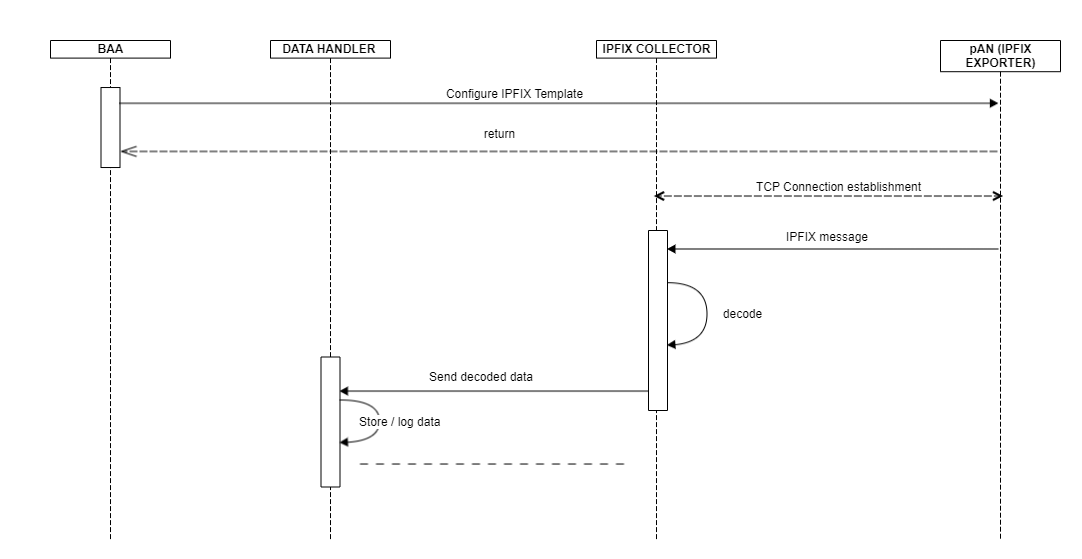
In this sequence diagram the BAA layer configures the pAN with the PM collection template. Once received the pAN establishes a connection to the Data Collector and sends the PM data encoded based on the information of the PM collection template. In this case, IPFIX is the method for PM data collection where the pAN takes on the role of a IPFIX exporter and sends its PM data encoded as IPFIX messages to the BAA layer's IPFIX collector. Upon reception of the PM data encoded in IPFIX messages, the IPFIX collector decodes the IPFIX messages into the requisite IPFIX IEs and then sends the decoded IEs to subscribed Data Handlers.
Deployment Architecture
The IPFIX collector is bundled as docker image and deployment is similar to BAA core service. The IPFIX collector listens for the IPFIX stream on default port 4494 that is configurable via the docker-compose file. The docker-compose file will also include the mount point from where the IPFIX_IEId.csv file is located.
Sample IPFIX Collector docker-compose file
version: '3.5'
networks:
baadist_default:
driver: bridge
name: baadist_default
services:
ipfix-collector:
image: ipfix-collector
container_name: ipfix-collector
restart: always
ports:
- "4494:4494"
environment:
- IPFIX_COLLECTOR_PORT=4494
- IPFIX_IE_MAPPING_DIR=/ipfix/ie-mapping/
volumes:
- /baa/stores/ipfix:/ipfix/ie-mapping/
networks:
- baadist_default
PM Data Handler Description
The PM Data Handler supports persistency of IPFIX data in form of a time series DB. InfluxDB version 2.0.0 is used for this. Access to persisted data is accomplished using the InfluxDB api.
-
Init and shutdown: On the init event the PM Data handler connects to the TSDB and registers at the IPFIX Collector. During shutdown the opposite operations in opposite order are executed.
-
Handling of IPFIX messages: The IPFIXMessage is parsed to create an array of DB tags from all data except for the timestamp and the counter values. Tags should be of data type String and Counter should be of type long, double, boolean or string depending on the data type of the counter.
IPFIX Background Material
This section of the document provides background material on the IPFIX protocol that is useful in understanding how to the IPFIX Collector in the BAA layer and IPFIX exporter in the pAN establish sessions and exchange information.
RFC Link : https://tools.ietf.org/html/rfc7011
The IPFIX messages from the pAN can be either data set, template set or options template set https://tools.ietf.org/html/rfc7011#section-3 with examples presented in https://tools.ietf.org/html/rfc7011#appendix-A.

Message Header
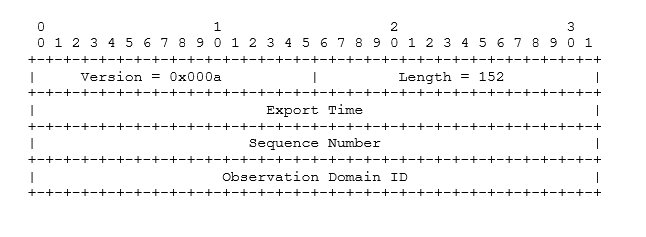
Template Set Example
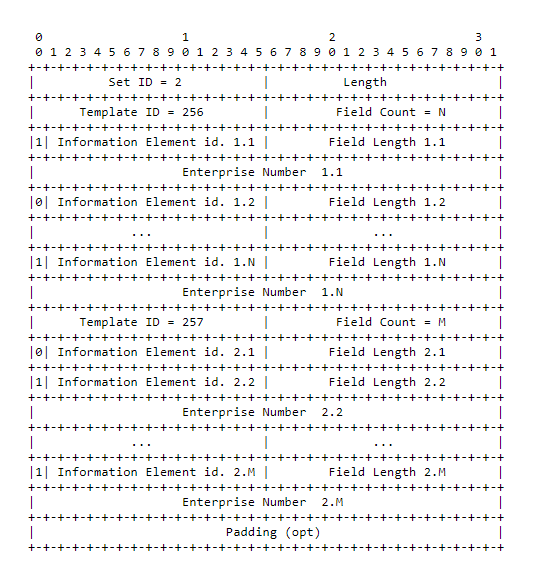
Options Template Set Example
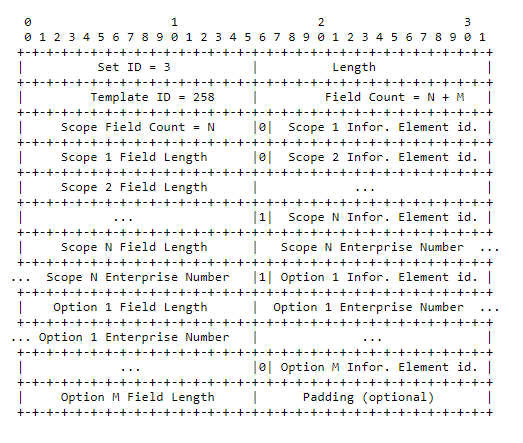
Data Set Example
